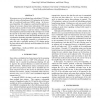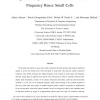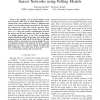146
Voted
INFOCOM
2011
IEEE
14 years 4 months ago
2011
IEEE
—How much information can one send through a random ad hoc network of
126
Voted
ICASSP
2011
IEEE
14 years 4 months ago
2011
IEEE
The problem of passive localization is commonly solved by independently measuring intermediate parameters (such as angles of arrival (AOA), times of arrival (TOA)...) on several m...
111
click to vote
ICASSP
2011
IEEE
14 years 4 months ago
2011
IEEE
We propose a novel, coordinated user scheduling (CUS) algorithm for inter-cell interference (ICI) mitigation in the downlink of a multi-cell multi-user MIMO system. In the propose...
129
click to vote
TON
2010
14 years 7 months ago
2010
Abstract--Energy efficiency is critical for wireless sensor networks. The data-gathering process must be carefully designed to conserve energy and extend network lifetime. For appl...
112
Voted
EJASP
2011
14 years 8 months ago
2011
We develop and analyze a space time coded cooperative diversity protocol that achieves improved quality of service for mobile users in the downlink of small cells. The protocol, c...
129
Voted
ICDCS
2009
IEEE
14 years 10 months ago
2009
IEEE
We study the multicast capacity for hybrid wireless networks consisting of ordinary wireless nodes and base stations under Gaussian Channel model, which generalizes both the unica...
111
click to vote
WIOPT
2010
IEEE
14 years 11 months ago
2010
IEEE
By analogy with an approach widely used in physics, we consider a discrete set of base stations (BS) as a continuum of transmitters. This model allows us to establish a simple clos...
107
Voted
GLOBECOM
2010
IEEE
14 years 11 months ago
2010
IEEE
In this paper we show how to quantify dependency between the node distributions of wireless networks and the underlying population densities. Furthermore, we show that a quantitati...
116
click to vote
CNSR
2010
IEEE
14 years 11 months ago
2010
IEEE
We focus on the interference between mobile stations as they attempt to gain access to an OFDMA-based WiMAX/IEEE 802.16 network. We propose a set of strategies that enable base st...
115
Voted
WIOPT
2010
IEEE
14 years 11 months ago
2010
IEEE
—We consider a Ferry based Wireless Local Area Network (FWLAN), in which information is forwarded from a base station to sensors, or gathered from sensors to a base station using...




